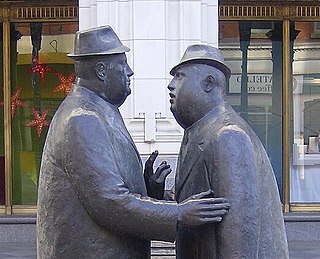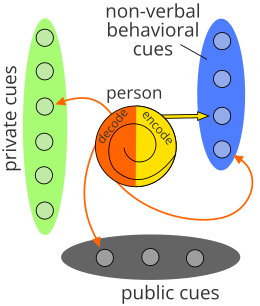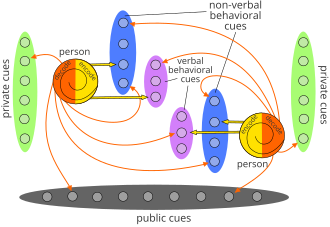
Communication is usually defined as the transmission of information. The term can also refer to the message itself, or the field of inquiry studying these transmissions, also known as communication studies. The precise definition of communication is disputed. Controversial issues are whether unintentional or failed transmissions are included and whether communication does not just transmit meaning but also creates it. Models of communication aim to provide a simplified overview of its main components and their interaction. Many models include the idea that a source uses a coding system to express information in the form of a message. The source uses a channel to send the message to a receiver who has to decode it in order to understand its meaning. Channels are usually discussed in terms of the senses used to perceive the message, like hearing, sight, smell, touch, and taste.
Human communication, or anthroposemiotics, is a field of study dedicated to understanding how humans communicate. Humans' ability to communicate with one another would not be possible without an understanding of what we are referencing or thinking about. Because humans are unable to fully understand one another's perspective, there needs to be a creation of commonality through a shared mindset or viewpoint. The field of communication is very diverse, as there are multiple layers of what communication is and how we use its different features as human beings.

Intrapersonal communication is communication with oneself or self-to-self communication. Examples are thinking to oneself "I'll do better next time" after having made a mistake or imagining a conversation with one's boss in preparation for leaving work early. It is often understood as an exchange of messages in which the sender and the receiver is the same person. Some theorists use a wider definition that goes beyond message-based accounts and focuses on the role of meaning and making sense of things. Intrapersonal communication can happen alone or in social situations. It may be prompted internally or occur as a response to changes in the environment. The term "autocommunication" is sometimes used as a synonym.
Two-way communication is a form of transmission in which both parties involved transmit information. Two-way communication has also been referred to as interpersonal communication. Common forms of two-way communication are:

Nonverbal communication (NVC) is the transmission of messages or signals through a nonverbal platform such as eye contact, facial expressions, gestures, posture, use of objects and body language. It includes the use of social cues, kinesics, distance (proxemics) and physical environments/appearance, of voice (paralanguage) and of touch (haptics). A signal has three different parts to it, including the basic signal, what the signal is trying to convey, and how it is interpreted. These signals that are transmitted to the receiver depend highly on the knowledge and empathy that this individual has. It can also include the use of time (chronemics) and eye contact and the actions of looking while talking and listening, frequency of glances, patterns of fixation, pupil dilation, and blink rate (oculesics).
Unconsciouscommunication is the subtle, unintentional, unconscious cues that provide information to another individual. It can be verbal or it can be nonverbal. Some psychologists instead use the term honest signals because such cues are involuntary behaviors that often convey emotion whereas body language can be controlled. Many decisions are based on unconscious communication, which is interpreted and created in the right hemisphere of the brain. The right hemisphere is dominant in perceiving and expressing body language, facial expressions, verbal cues, and other indications that have to do with emotion but it does not exclusively deal with the unconscious.
Intercultural communication is a discipline that studies communication across different cultures and social groups, or how culture affects communication. It describes the wide range of communication processes and problems that naturally appear within an organization or social context made up of individuals from different religious, social, ethnic, and educational backgrounds. In this sense, it seeks to understand how people from different countries and cultures act, communicate, and perceive the world around them. Intercultural communication focuses on the recognition and respect of those with cultural differences. The goal is mutual adaptation between two or more distinct cultures which leads to biculturalism/multiculturalism rather than complete assimilation. It promotes the development of cultural sensitivity and allows for empathic understanding across different cultures.
Marketing Communications refers to the use of different marketing channels and tools in combination. Marketing communication channels focus on how businesses communicate a message to its desired market, or the market in general. It is also in charge of the internal communications of the organization. Marketing communication tools include advertising, personal selling, direct marketing, sponsorship, communication, public relations, social media, customer journey and promotion.
Decoding, in semiotics, is the process of interpreting a message sent by an addresser (sender) to an addressee (receiver). The complementary process – creating a message for transmission to an addressee – is called encoding.
Interpersonal deception theory (IDT) is one of a number of theories that attempts to explain how individuals handle actual deception at the conscious or subconscious level while engaged in face-to-face communication. The theory was put forth by David Buller and Judee Burgoon in 1996 to explore this idea that deception is an engaging process between receiver and deceiver. IDT assumes that communication is not static; it is influenced by personal goals and the meaning of the interaction as it unfolds. The sender's overt communications are affected by the overt and covert communications of the receiver, and vice versa. IDT explores the interrelation between the sender's communicative meaning and the receiver's thoughts and behavior in deceptive exchanges.
The encoding/decoding model of communication was first developed by cultural studies scholar Stuart Hall in 1973. Stuart Hall pronounced the study as 'Encoding and Decoding in the Television Discourse.' Hall's essay offers a theoretical approach of how media messages are produced, disseminated, and interpreted. Hall proposed that audience members can play an active role in decoding messages as they rely on their own social contexts and capability of changing messages through collective action.

Social information processing theory, also known as SIP, is a psychological and sociological theory originally developed by Salancik and Pfeffer in 1978. This theory explores how individuals make decisions and form attitudes in a social context, often focusing on the workplace. It suggests that people rely heavily on the social information available to them in their environments, including input from colleagues and peers, to shape their attitudes, behaviors, and perceptions.
The hyperpersonal model is a model of interpersonal communication that suggests computer-mediated communication (CMC) can become hyperpersonal because it "exceeds [face-to-face] interaction", thus affording message senders a host of communicative advantages over traditional face-to-face (FtF) interaction. The hyperpersonal model demonstrates how individuals communicate uniquely, while representing themselves to others, how others interpret them, and how the interactions create a reciprocal spiral of FtF communication. Compared to ordinary FtF situations, a hyperpersonal message sender has a greater ability to strategically develop and edit self-presentation, enabling a selective and optimized presentation of one's self to others.
The following outline is provided as an overview of and topical guide to communication:

Interpersonal communication is an exchange of information between two or more people. It is also an area of research that seeks to understand how humans use verbal and nonverbal cues to accomplish a number of personal and relational goals.

Models of communication are simplified representations of the process of communication. Most models try to describe both verbal and non-verbal communication and often understand it as an exchange of messages. Their function is to give a compact overview of the complex process of communication. This helps researchers formulate hypotheses, apply communication-related concepts to real-world cases, and test predictions. Despite their usefulness, many models are criticized based on the claim that they are too simple because they leave out essential aspects. The components and their interactions are usually presented in the form of a diagram. Some basic components and interactions reappear in many of the models. They include the idea that a sender encodes information in the form of a message and sends it to a receiver through a channel. The receiver needs to decode the message to understand the initial idea and provides some form of feedback. In both cases, noise may interfere and distort the message.

Aberrant decoding or aberrant reading is a concept used in fields such as communication and media studies, semiotics, and journalism about how messages can be interpreted differently from what was intended by their sender. The concept was proposed by Umberto Eco in an article published first in 1965 in Italian and in 1972 in English.
Nonverbal influence is the act of affecting or inspiring change in others' behaviors and attitudes by way of tone of voice or body language and other cues like facial expression. This act of getting others to embrace or resist new attitudes can be achieved with or without the use of spoken language. It is a subtopic of nonverbal communication. Many individuals instinctively associate persuasion with verbal messages. Nonverbal influence emphasizes the persuasive power and influence of nonverbal communication. Nonverbal influence includes appeals to attraction, similarity and intimacy.

The Source–Message–Channel–Receiver model is a linear transmission model of communication. It is also referred to as the Sender–Message–Channel–Receiver model, the SMCR model, and Berlo's model. It was first published by David Berlo in his 1960 book The Process of Communication. It contains a detailed discussion of the four main components of communication: source, message, channel, and receiver. Source and receiver are usually distinct persons but can also be groups and, in some cases, the same entity acts both as source and receiver. Berlo discusses both verbal and non-verbal communication and sees all forms of communication as attempts by the source to influence the behavior of the receiver. The source tries to achieve this by formulating a communicative intention and encoding it in the form of a message. The message is sent to the receiver using a channel and has to be decoded so they can understand it and react to it. The efficiency or fidelity of communication is defined by the degree to which the reaction of the receiver matches the purpose motivating the source.

Schramm's model of communication is an early and influential model of communication. It was first published by Wilbur Schramm in 1954 and includes innovations over previous models, such as the inclusion of a feedback loop and the discussion of the role of fields of experience. For Schramm, communication is about sharing information or having a common attitude towards signs. His model is based on three basic components: a source, a destination, and a message. The process starts with an idea in the mind of the source. This idea is then encoded into a message using signs and sent to the destination. The destination needs to decode and interpret the signs to reconstruct the original idea. In response, they formulate their own message, encode it, and send it back as a form of feedback. Feedback is a key part of many forms of communication. It can be used to mitigate processes that may undermine successful communication, such as external noise or errors in the phases of encoding and decoding.











